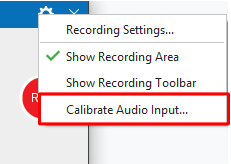ActivePresenter 9 allows users to detect the recording sensitivity level by calibrating audio input. This feature sets the audio recording devices to the appropriate level before recording. So, it reduces the chance of capturing overly loud or too quiet sounds, which don’t meet quality standards.
You can calibrate the microphone either automatically or manually. This tutorial will cover both methods to let you level-match your speakers. More interestingly, with the auto-calibration system in ActivePresenter 9, fine-tuning the recording system is almost done for you.
Let’s learn more about this feature to improve the sound recording quality through the main contents:
Download the app right now to try out the feature!

How to Calibrate Audio Input
Before recording voice for a video demo, interactive simulation, or narration, you can choose to adjust the audio input. This can help you to have outputs with the best possible sound.
Calibrate Audio Input When Recording Screen
To calibrate audio input when recording new projects, do the following: In the Record Video Project dialog or Record Interactive Simulation Project dialog, click the Settings button (Gear icon) in the top-right corner and select Calibrate Audio Input…

After that, a dialog pops up. We will discuss this dialog in detail in the latter part of this article.
Calibrate Audio Input When Recording Narration Only
To calibrate audio input when recording narration, do the following:
Step 1: Click the drop-down arrow on the Record Narration button (1) in the Timeline pane and select Recording Options (2).

Step 2: In the Recording Options dialog that pops up, click Calibrate Input… (3).

The Calibrate Audio Input dialog which is the same as the one mentioned above will pop up.
To know more details about recording narration, refer to How to Record Narration.
Calibrate Audio Input Automatically
First, take a look at the dialog below. It pops up when you click the Calibrate Audio Input…in the Settings or Calibrate Input… (3) above.

Now, take the following:
Step 1: Click the Auto Calibrate button (4). The Auto Calibrate button will turn into Stop Calibration.
Step 2: Speak something in your normal volume into the microphone. Keep speaking so that ActivePresenter can automatically optimize the gain.
After a few seconds, the button changes from Stop Calibration to Auto Calibrate again, which means the calibration is over.
Remember that you should try to speak louder or smaller during the testing time for a better result.
Calibrate Audio Input Manually
To calibrate the microphone manually in ActivePresenter 9, do the following:
Step 1: Keep the microphone in its normal position. Click the Record Narration button (5). This button will turn into the Stop button.
Step 2: Speak something into the microphone.
At the same time, move the slider (7) to the right until the LED bar on the right shows yellow bars intermittently.
If the bar starts showing red LEDs, move the slider a bit to the left.
Step 3: Click the Stop button to end the calibration when you are satisfied with the audio level.
Step 4: Click the Play button (6) to listen to the recorded voice. If the audio level is not good enough or if it has any defect such as breathing noise, repeat steps 1-4.
Regardless of the calibration method, the volume adjustment is accepted only when you click the OK button. If you click the Cancel button, ActivePresenter will discard the new value and apply the old one.
Tip: You can use the Audio Noise Reduction feature in ActivePresenter 9 to enhance the recorded voice. Refer to the Reduce Audio Noise tutorial for more details. So, we’ve gone through how to calibrate audio input with ActivePresenter 9. Don’t forget to visit our Tutorials page and YouTube channel for more useful tips to get the most out of the app.
See more: